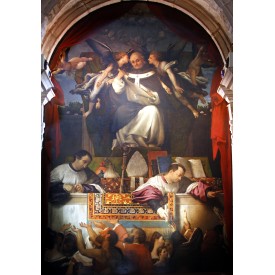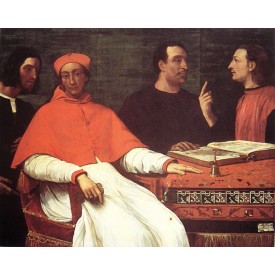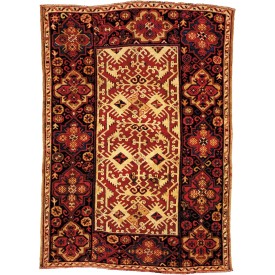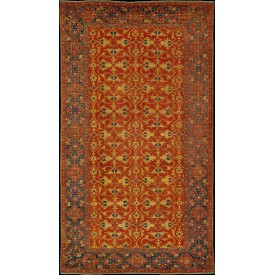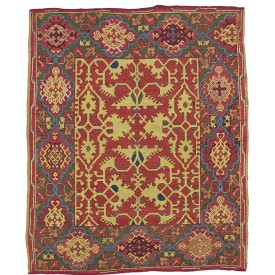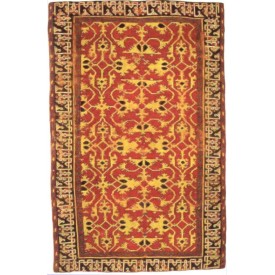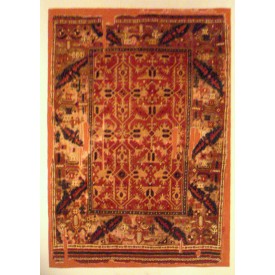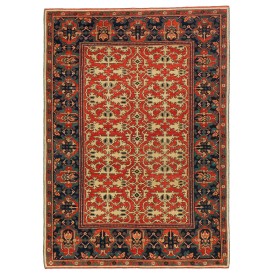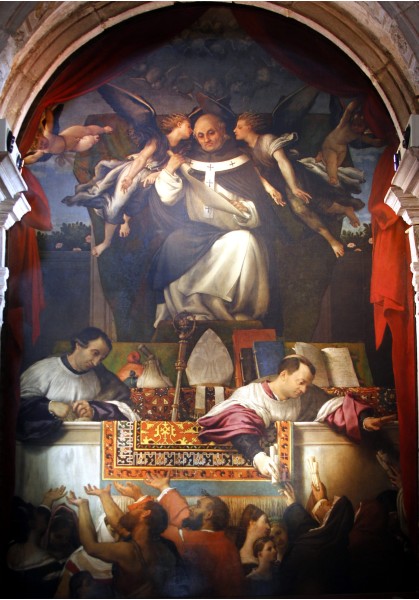
Rugs and carpets have a long history, with evidence of woven textiles dating back to ancient civilizations such as Egypt, China, and Persia. Over time, the designs and patterns of rugs and carpets have evolved to reflect different regions’ cultural and artistic influences.
In ancient times, rugs and carpets were primarily used for practical purposes such as insulation and to provide a soft surface to sit or sleep on. The designs were often simple geometric patterns or representations of nature.
During the Islamic Golden Age, from the 8th to the 13th century, rug and carpet weaving became a highly developed art form in Persia, Turkey, and Egypt. The designs of these rugs were influenced by Islamic art and architecture, featuring intricate geometric patterns and calligraphy.
In the 16th century, the Ottoman Empire became a major center for rug production. Turkish rugs began to feature bold, colorful designs, often with floral and animal motifs.
In the 19th and 20th centuries, the Industrial Revolution led to the mass production of rugs and carpets, and new synthetic dyes were developed, which allowed for a broader range of colors and designs. Carpets and rugs started to be produced in various styles, such as Art Deco, Art Nouveau, and Arts and Crafts.
Today, rugs and carpets are produced in a wide variety of designs and styles, reflecting the diverse cultural influences and artistic movements of different regions and periods.
12th to 13th Centuries:
The evolution of rugs and carpets in the 12th century was heavily influenced by the Islamic Golden Age. During that time, many of the techniques and designs that are still used today were developed. At this time, the most renowned centers for rug production were in Persia, Central Asia, and the Middle East, where the nomadic tribes began to settle and produce rugs for income. These early rugs were primarily made from wool. Bold geometric patterns and bright colors characterized them.
During the 12th century, the Seljuk Empire, centered in Iran and Iraq, was a major patron of the arts and encouraged the production of high-quality rugs. Under the Seljuks, the art of rug-making reached new heights of sophistication with the development of intricate designs and refined weaving techniques. The Seljuk rugs were known for using repeating patterns and complex geometric shapes, often featuring intricate medallion designs.
Besides the Seljuks, the Khwarezm Empire also significantly developed rug-making during this period. The rugs produced in this region were known for their high quality and featured bold geometric designs, bright colors, and a dense weave.
Overall, the 12th century was a time of great innovation in the rug-making world. Many of the techniques and designs that were developed during this time are still used today.
In the 13th century, the Islamic Golden Age peaked, and the production of rugs and carpets was highly developed. The Mongol Empire conquered Persia, and under the Ilkhanid dynasty (1256–1335), carpet and rug production flourished in Persia, present-day Iran. These carpets were known for their intricate geometric designs, bright colors, and high quality. The designs often featured repetitive patterns of medallions and arabesques, and the borders were often decorated with geometric patterns and calligraphy. In Europe, the Gothic period was still influencing art and architecture, and the designs of Gothic carpets featured bold geometric patterns with stylized animals and human figures. In Central Asia, the nomadic tribes continued to produce rugs with bold, geometric designs and bright colors. These carpets were made from wool and used for practical and decorative purposes. Overall, the 13th century saw the continuation of the Islamic Golden Age in rug and carpet production, with the output in Persia, present-day Iran, reaching its peak. The designs were influenced by Islamic art, architecture, and calligraphy, and the carpets were known for their intricate geometric patterns and high quality.
14th to 15th Centuries:
In the 14th century, the production of rugs and carpets continued to flourish in the Islamic world, particularly in Persia and present-day Iran, under the rule of the Ilkhanid dynasty. The designs of these carpets were influenced by Islamic art and architecture, featuring intricate geometric patterns and calligraphy. Using more naturalistic floral and animal motifs was also becoming more common. In Europe, the 14th century saw the start of the Renaissance, which significantly influenced art and architecture, including the design of rugs and carpets. The methods of Renaissance carpets were more naturalistic, featuring realistic floral and animal motifs. In Central Asia, the nomadic tribes continued to produce carpets with bold, geometric designs and bright colors, using the same techniques. Overall, the 14th century saw the continuation of the Islamic Golden Age in rug and carpet production, with the production in Persia and present-day Iran continuing to flourish. The designs were influenced by Islamic art, architecture, and calligraphy, and the carpets were known for their intricate geometric patterns and high quality. The use of more naturalistic floral and animal motifs became more common. In Europe, the start of the Renaissance influenced the design of rugs and carpets, which became more naturalistic.
In the 15th century, the Ottoman Empire emerged as a major center for rug production. Ottoman carpets began featuring bold, colorful designs, often floral and animal motifs. These designs were heavily influenced by the art and architecture of the Ottoman Empire, as well as the traditional motifs and techniques of the Islamic world. Using more complex geometric patterns, medallions, and arabesques became more common. In Europe, during the 15th century, the Renaissance period continued to influence the design of rugs and carpets, which became even more naturalistic, featuring realistic floral and animal motifs.
In Central Asia, the nomadic tribes continued to produce carpets with bold, geometric designs and bright colors, using the same techniques as before. The 15th century saw the Ottoman Empire becoming a significant center for rug production, with Ottoman carpets featuring bold, colorful designs and floral and animal motifs. The art and architecture of the Ottoman Empire and traditional motifs and techniques of the Islamic world heavily influenced the designs. During the Renaissance, Europe continued to influence the design of rugs and carpets, which became more naturalistic. In Central Asia, nomadic tribes continued to produce carpets with bold, geometric designs and bright colors, using the same techniques as before.
16th to 17th Centuries:
In the 16th and 17th centuries, the Ottoman Empire was a significant center for rug production, and Turkish rugs became increasingly popular throughout Europe. The art and architecture of the Ottoman Empire heavily influenced the designs of these rugs. They featured bold, colorful designs with floral and animal motifs, complex geometric patterns, medallions, and arabesques. During this time, the Ottoman Empire also began to export rugs to Europe. The designs began to incorporate more European elements, such as coats of arms, cartouches, and other heraldic symbols and European colors. This period also saw the development of the “Transylvanian” rugs produced in present-day Romania under Ottoman rule and featured a unique blend of Ottoman and European design elements. During the 16th and 17th centuries in Europe, the Baroque period influenced the design of rugs and carpets, which became more ornate and opulent. The use of more luxurious materials, such as silk, became more common, and the designs often featured scrolling floral patterns and more realistic representations of figures and animals. Overall, the 16th and 17th centuries saw the Ottoman Empire continue to be a significant center for rug production, and Turkish rugs became increasingly popular throughout Europe. The art and architecture of the Ottoman Empire influenced the designs of these rugs. They featured bold, colorful designs with floral and animal motifs, complex geometric patterns, medallions, and arabesques. Ottoman Empire also began to export rugs to Europe, and the plans began to incorporate more European elements, such as coats of arms, cartouches, and other heraldic symbols. During the Baroque period, rugs and carpet designs in Europe became more ornate and opulent, using more luxurious materials and realistic representations of figures and animals.
Like other classical carpet examples, Lotto Carpets have been reinterpreted, and their designs evolved between the 16th and 17th centuries.
18th to 19th Centuries:
In the 18th and 19th centuries, the production of rugs and carpets continued to be an essential industry in the Ottoman Empire and other Islamic countries, and Turkish rugs remained popular throughout Europe. The art and architecture of the Ottoman Empire heavily influenced the designs of these rugs. They featured bold, colorful designs with floral and animal motifs, complex geometric patterns, medallions, and arabesques. In Europe, during the 18th century, the Rococo style emerged and significantly influenced the design of rugs and carpets. These designs became more delicate and ornate, featuring scrolling floral patterns, and pastel colors became more common. In the 19th century, the Industrial Revolution led to the mass production of rugs and carpets. New synthetic dyes were developed, allowing for a wider range of colors and designs. Carpets and rugs started to be produced in various styles, such as Art Deco, Art Nouveau, and Arts and Crafts. In the Ottoman Empire, traditional rug-making techniques continued to be used, but the designs began incorporating more Western styles and motifs. In Europe and North America, the Victorian era saw a resurgence of interest in oriental rugs and carpets, and many manufacturers began producing machine-made copies of traditional designs. Overall, the 18th and 19th centuries saw a continuation of the Ottoman Empire; Islamic countries were major centers for rug production, and Turkish rugs remained popular throughout Europe. The art and architecture of the Ottoman Empire heavily influenced the designs of these rugs. They featured bold, colorful designs with floral and animal motifs, complex geometric patterns, medallions, and arabesques. The Industrial Revolution led to the mass production of rugs and carpets, and new synthetic dyes were developed, which allowed for a wider range of colors and designs. Carpets and rugs were produced in various styles, such as Art Deco, Art Nouveau, and Arts and Crafts. Traditional rug-making techniques continued to be used in the Ottoman Empire, but the designs began incorporating more Western styles and motifs. In Europe and North America, the Victorian era saw a resurgence of interest in oriental rugs and carpets, and many manufacturers began producing machine-made copies of traditional designs.
20th to 21st Centuries:
In the 20th century, the production of rugs and carpets underwent significant changes due to technological advancements and changing cultural influences. In the early 20th century, the Art Deco and Art Nouveau movements significantly influenced rug and carpet design. These designs featured bold geometric patterns and bright colors, with stylized floral and animal motifs. During the 1950s and 1960s, abstract and minimalist designs became popular, as well as the use of new materials such as nylon and other synthetic fibers. In the latter half of the 20th century, there was a renewed interest in traditional rug-making techniques. Many artists and designers began creating hand-woven, one-of-a-kind rugs using natural fibers such as wool and silk. In the last decades of the 20th century, there was a growing awareness of mass-produced rugs' cultural and environmental impact, which led to the rise of fair trade and sustainable rug-making practices. In the late 20th century, the Modern and Contemporary art movements impacted rug and carpet designs, often featuring abstract, geometric, and conceptual patterns. Overall, the 20th century saw the production of rugs and carpets undergo significant changes due to technological advancements and changing cultural influences. Different art movements, from Art Deco, Art Nouveau, Abstract, and Minimalism to Modern and Contemporary, had an impact on the designs.
In the 21st century, the production of rugs and carpets continues to evolve with the incorporation of new technologies and changing design trends. Digital printing and other new technologies have created unique designs and reproductions of traditional patterns, allowing for more intricate and detailed designs. Additionally, there is a growing interest in sustainable and eco-friendly rug production, with more manufacturers using natural fibers and environmentally friendly dyes. There has also been a resurgence of interest in traditional rug-making techniques, with many contemporary designers and artists creating handmade, one-of-a-kind pieces that draw inspiration from traditional patterns and motifs.
20th to 21st Centuries:
In the 20th century, the production of rugs and carpets underwent significant changes due to technological advancements and changing cultural influences. In the early 20th century, the Art Deco and Art Nouveau movements significantly influenced rug and carpet design. These designs featured bold geometric patterns and bright colors, with stylized floral and animal motifs. During the 1950s and 1960s, abstract and minimalist designs became popular, as well as the use of new materials such as nylon and other synthetic fibers. In the latter half of the 20th century, there was a renewed interest in traditional rug-making techniques. Many artists and designers began creating hand-woven, one-of-a-kind rugs using natural fibers such as wool and silk. In the last decades of the 20th century, there was a growing awareness of mass-produced rugs' cultural and environmental impact, which led to the rise of fair trade and sustainable rug-making practices. In the late 20th century, the Modern and Contemporary art movements impacted rug and carpet designs, often featuring abstract, geometric, and conceptual patterns. Overall, the 20th century saw the production of rugs and carpets undergo significant changes due to technological advancements and changing cultural influences. Different art movements impacted the designs, from Art Deco, Art Nouveau, Abstract, Minimalism, and Modern and Contemporary.
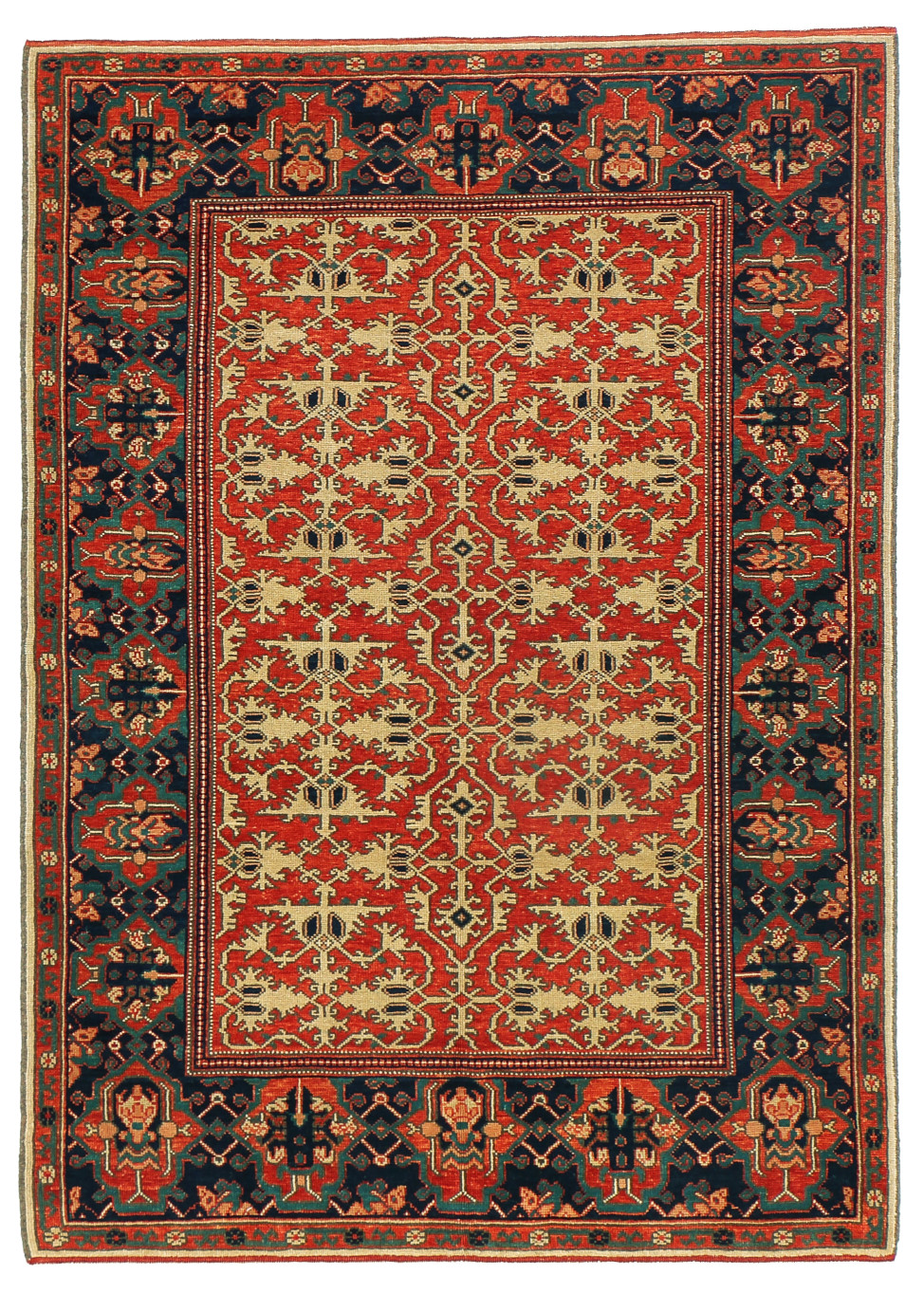 21st Century Lotto Carpet, Reinterpreted by Ararat Rugs
21st Century Lotto Carpet, Reinterpreted by Ararat Rugs
In the 21st century, the production of rugs and carpets continues to evolve with the incorporation of new technologies and changing design trends. Digital printing and other new technologies have created unique designs and reproductions of traditional patterns, allowing for more intricate and detailed designs. Additionally, there is a growing interest in sustainable and eco-friendly rug production, with more manufacturers using natural fibers and environmentally friendly dyes. There has also been a resurgence of interest in traditional rug-making techniques, with many contemporary designers and artists creating handmade, one-of-a-kind pieces that draw inspiration from traditional patterns and motifs.
While examining our website, the 100% natural carpets we produce, you will notice that their designs and sources belong to some books or museums. Here, we are working day and night to search the various books and catalogs, choose the ones that have not been reinterpreted before, with our design changes like the changes done in previous centuries, give them a second life by producing them, and pass these designs to the next generations.

